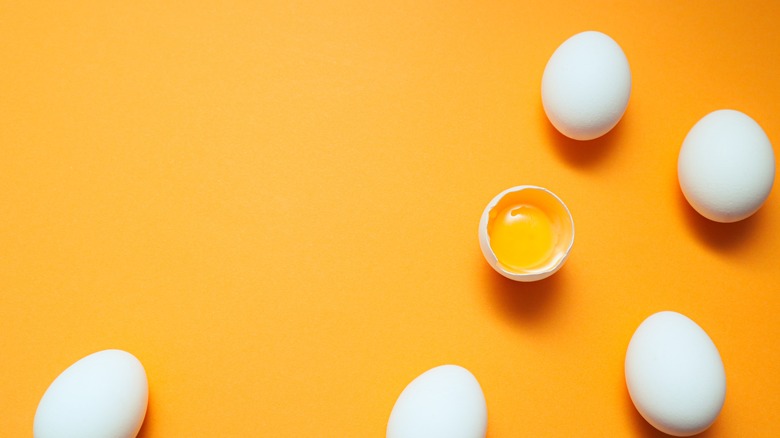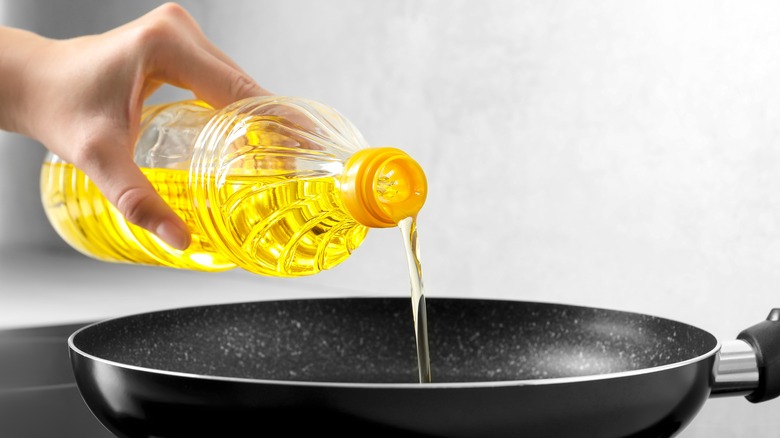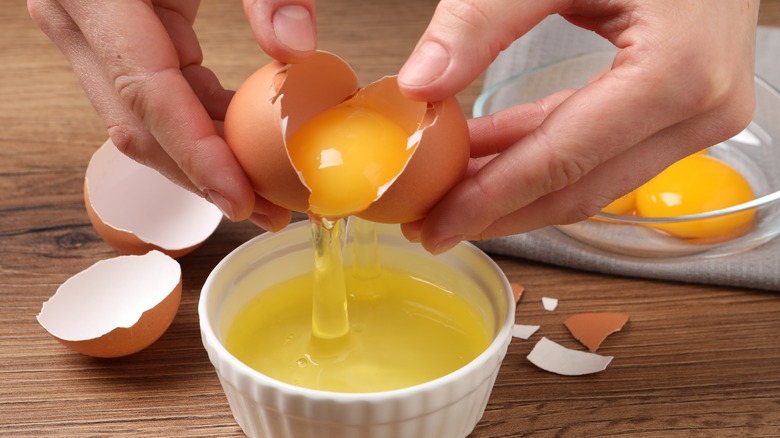The Perfect Temperature To Deep Fry Eggs Without Breaking Them
From Oreos to cauliflower to ice cream to cheese, people have found a way to deep fry just about everything. Deep frying food gives it a nice, crispy outer texture and a soft, warm, and gooey inner texture. This begs the question: if you can pan-fry an egg, can you deep-fry an egg? As it turns out, you can, and the result is just as delicious as you'd expect.
Before learning about the perfect temperature for deep fried eggs, it's helpful to understand a bit about the science of deep frying. Typically, you deep fry food in oil, often vegetable oil or peanut oil. Depending on the food you're cooking, the oil can get very hot, up to 400 degrees Fahrenheit. This causes water to boil to the surface of the food and interact with the oil. If you've dipped your food in flour or a batter or you're frying a starch-heavy food like potatoes, a starchy barrier forms, resulting in a deliciously crispy outside and tender inside. For non-starchy foods like eggs, you'll simply get a crispy, crunchy outside from the heat and browning.
This general process is the same for all fried foods, but the technique and temperature can vary slightly depending on what you're cooking. For example, when it comes to frying eggs, you don't want to heat your oil all the way to 400 degrees Fahrenheit. In general, fried eggs should be cooked at a lower temperature — usually between 320 and 375 degrees Fahrenheit — but for deep-frying you can aim for the lowest end of that spectrum.
Why deep frying temperature matters
Water begins to evaporate at 212 degrees Fahrenheit. This is much lower than the temperature of the oil, whether you're frying eggs or Oreos. The key to delicious fried food is in obtaining that perfect temperature. As the outer temperature of the food heats up when it comes into contact with the oil, water escapes via vapor. This is what you're watching happen when fried food bubbles up. As that moisture content gets pulled out of the outer crust, it gets nice and crispy.
When it comes to frying eggs, the temperature of the oil has to be in that sweet spot to prevent the egg from breaking apart and getting too rubbery. Ideally, you should keep the temperature on the lowest end of the 320 and 375 degrees Fahrenheit range possible, shooting for 320 degrees but at least below 350 degrees Fahrenheit. According to the Egg Safety Center fried eggs should be cooked to an internal temperature of 144 to 158 degrees Fahrenheit, though the USDA is a bit more conservative, suggesting that eggs be cooked to 160 degrees Fahrenheit.
Either temperature will be easily achieved when deep frying, particularly if you use a lower heat, which should allow your yolks to heat through without burning the outside of your eggs. But to make sure you're staying within that ideal range, keep an instant thermometer in your pot and adjust the heat as needed. While you're waiting for your oil to heat up, check out some other tips to make the best fried eggs.
How to deep fry an egg
The first step in deep frying an egg is to crack your egg into a cup or small container. Then, you'll want to heat up your oil. Grab a deep-sided frying pan, a small pot, or a wok, and fill it with enough oil that your egg can be at least partially submerged.
When your oil reaches the correct temperature, drop the cracked egg into your pan. The whites should begin to bubble up and cook immediately, and the hot oil will likely crack and spit from the pan. If your oil is deep enough, you can gently flip your egg over after 20 or 30 seconds. Otherwise, as your egg cooks take a spoon and ladle the hot oil over the top of your egg until a layer of cooked egg whites forms over the yolk. Be prepared to move quickly; your egg should cook in less than a minute.
You'll know the egg is done when the egg whites are completely set — they shouldn't be jiggly anymore. The outside edges should be bubbly, and crisp, but the yolk will be nice and runny inside. Because there is no breading on the egg, it won't absorb the oil like many other deep-fried foods so place it on a paper towel after frying to soak up excess oil. Next time you're fixing up a batch of fried eggs, consider deep-frying instead of pan-frying, and you'll have a deliciously crispy and gooey addition to your breakfast.


